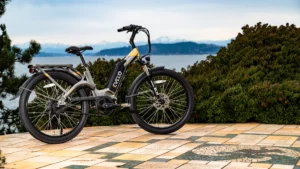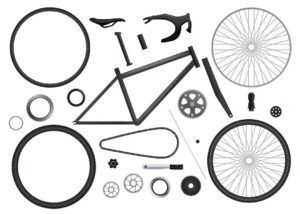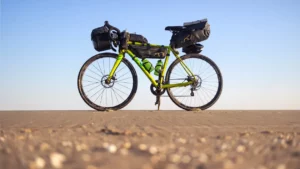The bicycle, a marvel of human ingenuity, is more than the sum of its parts. Central to its smooth operation is the rear derailleur—a crucial yet often overlooked component. But do you know how the rear derailleur plays a role in bicycle mechanics? This article will tell what is a rear derailleur, how it works, and the types of rear derailleur. Let’s unveil the intricacies of gear shifting and enhance our appreciation for this finely tuned machine.
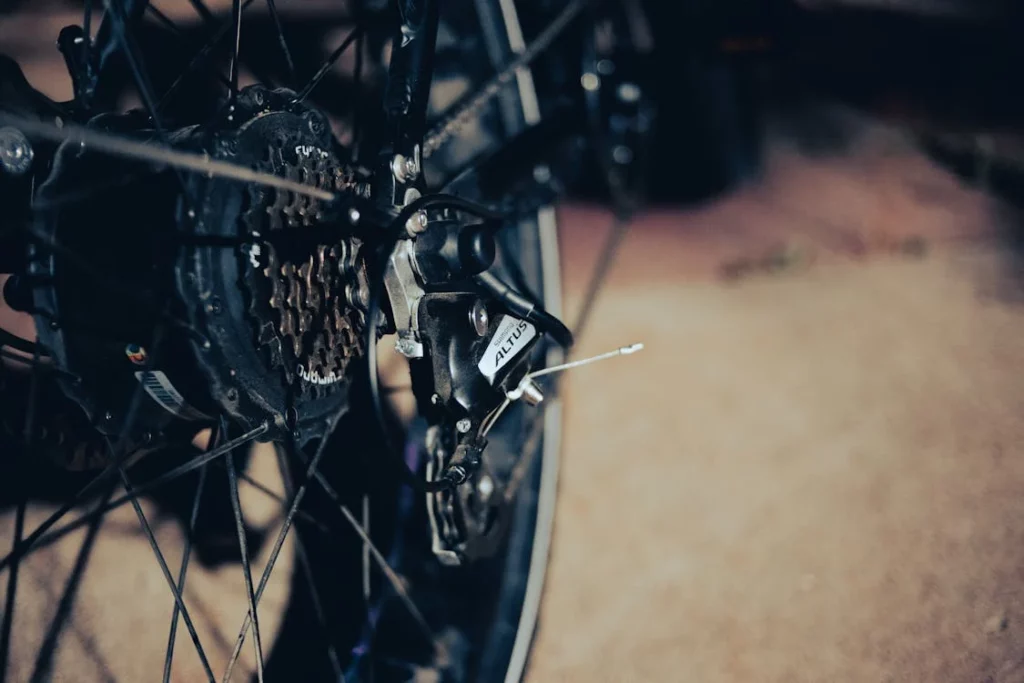
What Is a Rear Derailleur?
A rear derailleur is a mechanical component of a bicycle that shifts the chain across the sprockets of the rear cassette, allowing the rider to change gears. This enables efficient pedaling by adjusting to different terrains and maintaining optimal cadence. A good rear derailleur benefits:
- Smooth Gear Shifting: Facilitates seamless transitions between gears for an efficient ride.
- Adaptability: Allows cyclists to adjust gear ratios to suit different terrains, enhancing versatility.
- Improved Efficiency: Helps maintain an optimal cadence, reducing fatigue and increasing riding comfort.
- Enhanced Performance: Essential for high-performance cycling, offering precision and reliability.
- Protection: The derailleur hanger absorbs impact, protecting the derailleur and bike frame from damage.
What Is Shimano Rear Derailleur?
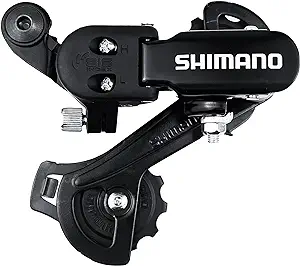
A Shimano rear derailleur is a high-performance component designed by Shimano, a leading manufacturer in the cycling industry. It is specifically engineered to facilitate smooth and precise shifting of the bicycle chain across the rear cassette’s sprockets. Shimano rear derailleurs come in various models, each catering to different cycling disciplines and preferences, from road cycling to mountain biking. These derailleurs are known for their durability, innovative design features, and compatibility with Shimano’s extensive range of drivetrain components.
Shimano Derailleur Ratings
Shimano categorizes its rear derailleurs into different series and ratings based on their intended use and performance characteristics. Here’s a breakdown of Shimano derailleur ratings:
- Entry-Level (Tourney, Altus): Basic models suitable for recreational and entry-level cyclists. They offer reliable performance at an affordable price point but may lack some of the advanced features found in higher-end models.
- Mid-Range (Deore, SLX): These derailleurs strike a balance between performance and affordability, making them popular among enthusiasts and amateur riders. They often feature lightweight materials, improved shifting performance, and durability suitable for varied terrain.
- High-End (XT, XTR): Designed for serious cyclists and professionals, high-end Shimano derailleurs prioritize lightweight construction, precision engineering, and advanced technologies. They offer superior shifting accuracy, and enhanced durability, and are often equipped with features like Shadow Plus technology for improved chain retention and reduced noise.
- Electronic (Di2): Shimano’s electronic derailleurs represent the pinnacle of cycling technology. They use electronic signals for gear shifts, offering unmatched precision, customizable shifting options, and seamless integration with other electronic components. Di2 derailleurs are favored by competitive cyclists for their reliability and performance under demanding conditions.
Shimano Derailleur Ranking
Here’s a general ranking of the Shimano derailleur series based on their intended use and performance:
Shimano Tourney (TY):
- Entry-level derailleurs are suitable for recreational and beginner cyclists.
- Basic functionality and affordability.
- Ideal for casual riding and light commuting.
Shimano Altus (M2000, M3100):
- Improved performance over Tourney with smoother shifting.
- Suitable for recreational mountain biking and urban commuting.
- Provides reliable performance at a budget-friendly price.
Shimano Acera (M3000, M3600):
- Upgraded components offer better durability and smoother shifts.
- Designed for recreational and entry-level mountain biking.
- Features advancements like Rapidfire Plus shifting technology.
Shimano Alivio (M4000, M3100):
- Mid-range derailleurs offer enhanced performance and durability.
- Suitable for more demanding recreational mountain biking and touring.
- Features Shadow RD technology for improved chain stability and reduced noise.
Shimano Deore (M5100, M6100, M7100):
- High-performance derailleurs for serious mountain biking enthusiasts.
- Lightweight construction with advanced shifting technologies.
- Provides precise and responsive shifting across a wide range of gears.
Shimano SLX (M7100):
- Provides performance similar to Deore but with additional features.
- Designed for aggressive trail riding and enduro racing.
- Offers enhanced durability and smoother shifting under load.
Shimano XT (M8100):
- Top-tier performance for professional and competitive cyclists.
- Lightweight, durable construction with cutting-edge technologies.
- Features include Hyperglide+ for smoother shifting and improved chain retention.
Shimano XTR (M9100):
- The pinnacle of Shimano’s mountain bike drivetrain technology.
- Ultra-lightweight design with the highest level of precision and reliability.
- Designed for elite-level racing and uncompromising performance.
Shimano Di2 Electronic Shift Systems:
- State-of-the-art electronic derailleurs offer unparalleled precision.
- Allows for customizable shifting options and seamless integration with other Di2 components.
- Ideal for competitive cyclists and enthusiasts seeking the ultimate in-shifting performance.
Components of a Rear Derailleur
A rear derailleur is a complex assembly of components, each contributing to its overall functionality. Understanding these parts can demystify its operation and aid in maintenance and troubleshooting.
The Derailleur Cage
The derailleur cage, a pivotal component, is the part that holds the jockey wheels and guides the chain across the gears. It comes in different lengths—short, medium, and long—each suited to different gear ranges and applications. A longer cage can handle a wider range of gears, making it ideal for mountain bikes with diverse terrain, while a shorter cage is typically used for road bikes, where precision and weight savings are paramount.
Jockey Wheels
Jockey wheels, also known as pulley wheels, are the small wheels within the derailleur cage that guide the chain. They are critical for smooth and efficient shifting. High-quality jockey wheels reduce friction and wear, contributing to a more responsive and quieter ride. Some advanced models come with ceramic bearings for enhanced performance and durability.
Derailleur Hanger
The derailleur hanger is a small but crucial part that attaches the derailleur to the bike frame. Its primary function is to protect the derailleur and frame by bending or breaking in the event of an impact, thereby absorbing the force that might otherwise damage the more expensive components. A misaligned or damaged hanger can severely impair shifting performance, making regular inspection and maintenance essential.
The Limit Screws
Limit screws are small adjustment screws on the derailleur that set the upper and lower boundaries of the derailleur’s movement. Properly adjusted limit screws prevent the chain from overshooting the largest or smallest sprockets, which can cause chain derailment and potential damage to the drivetrain. Fine-tuning these screws is a delicate process that ensures precise and reliable gear changes.
Types of Rear Derailleurs
The evolution of rear derailleurs has led to the development of various types, each designed to meet the specific needs and preferences of cyclists.
Traditional Derailleurs
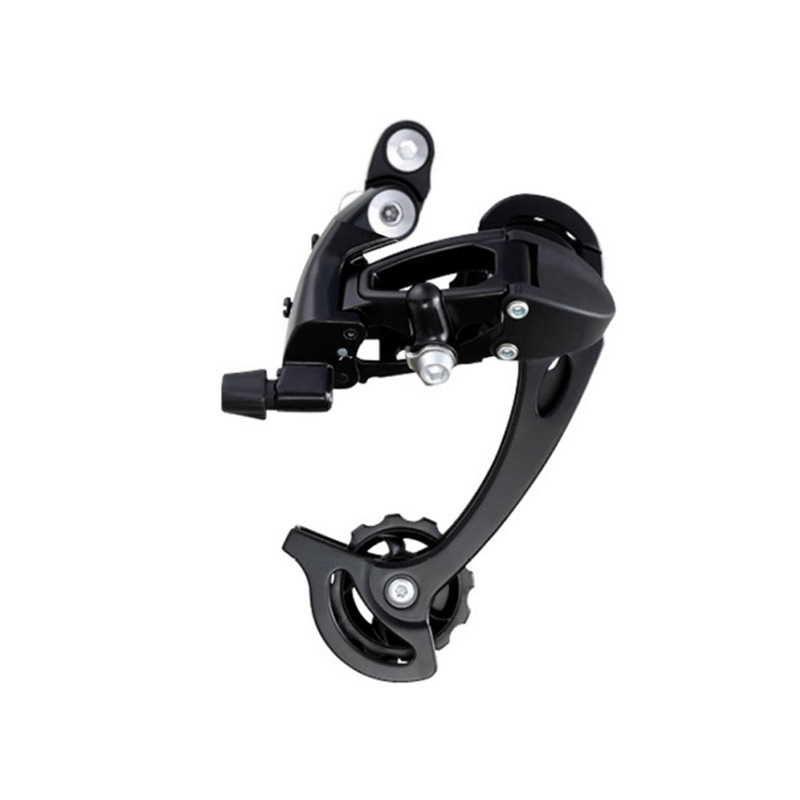
Traditional derailleurs are mechanically operated via a cable connected to the gear shifter. They rely on precise cable tension to shift gears. For example, SHINE SOON TP-190021 is a 9-speed bicycle rear derailleur with a tail hook, that boasts smooth and precise speed change, compatible with Shimano. These derailleurs are cost-effective, relatively easy to maintain, and widely used in many types of bicycles. However, they require regular adjustment to maintain optimal performance as the cables stretch and wear over time.
Modern Derailleurs
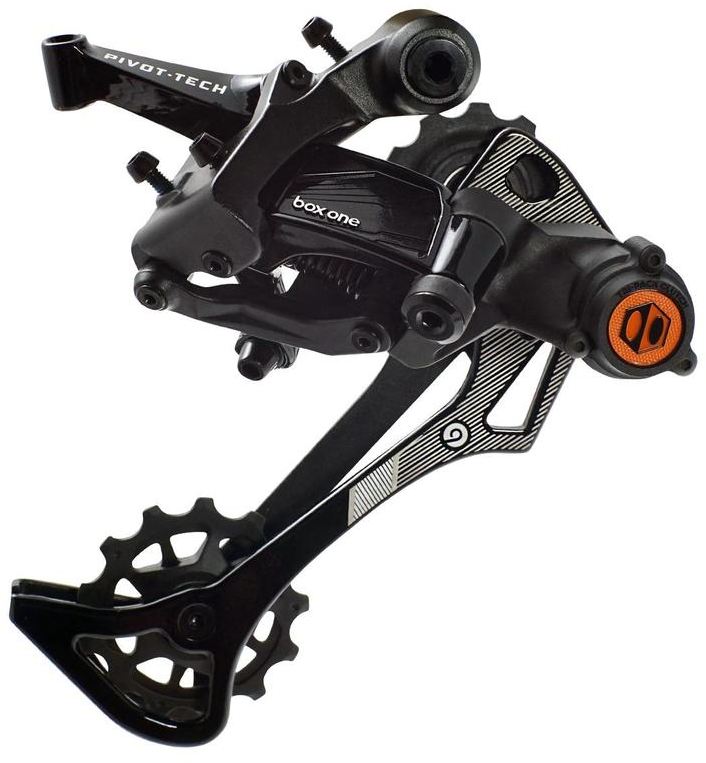
Modern derailleurs, while still cable-operated, incorporate advanced materials and engineering for enhanced performance. They often feature refined geometries, lighter materials, and more precise mechanisms. Innovations such as Shadow Plus technology, found in some Shimano models, reduce chain slap and improve stability, particularly on rough terrain.
Electronic Derailleurs
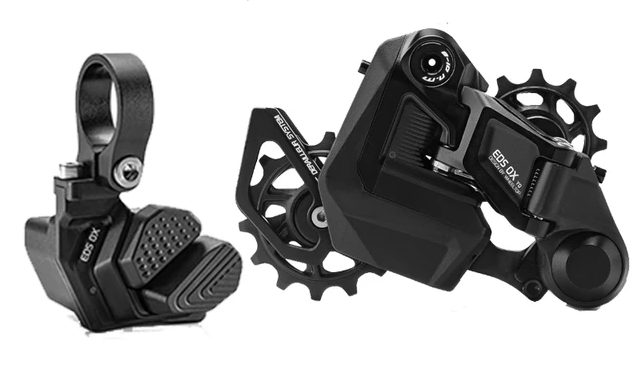
Electronic derailleurs represent the cutting edge of bicycle technology. These derailleurs use electronic signals to shift gears, eliminating the need for cables. They offer unparalleled precision, ease of use, and the ability to shift under load. Systems like Shimano Di2 and SRAM eTap allow for customizable shifting patterns and can be integrated with other electronic components for a seamless cycling experience. However, they come with a higher price tag and require battery management.
Clutch Derailleurs
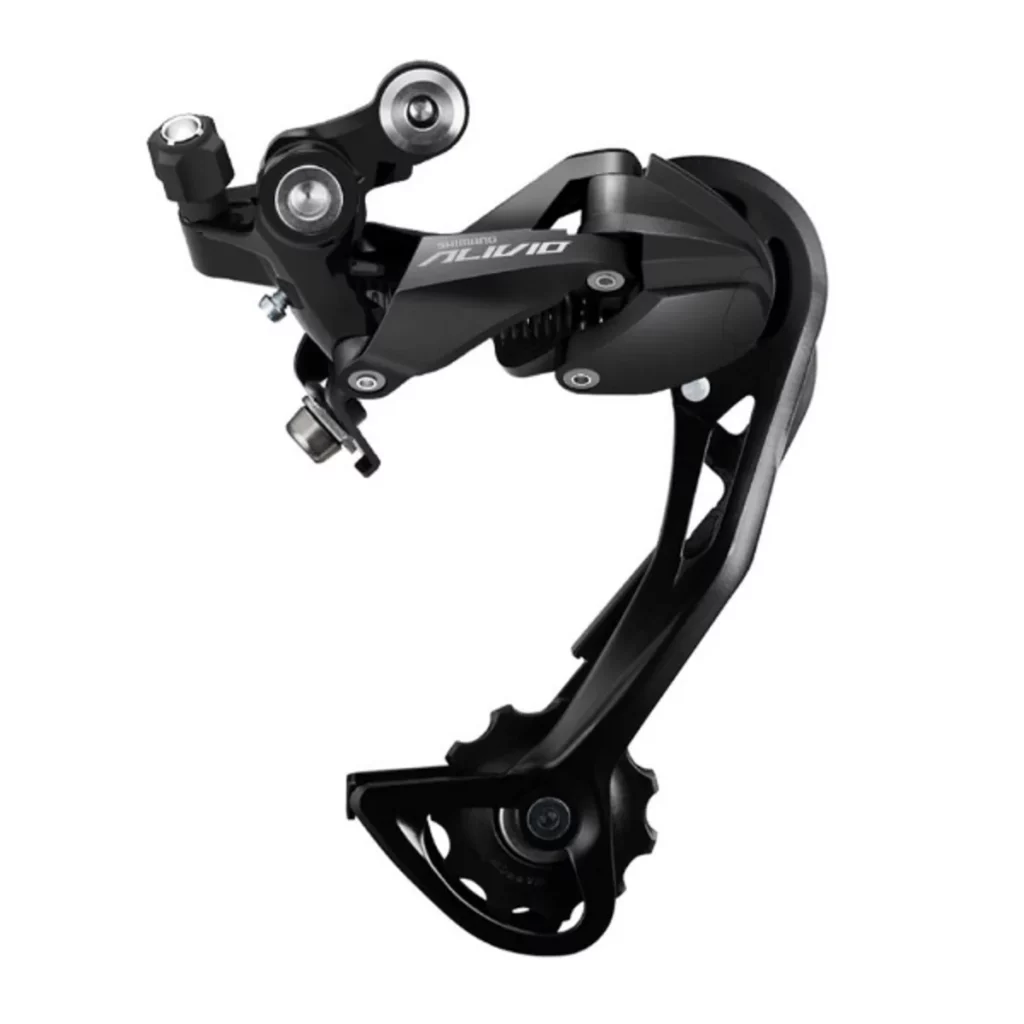
Clutch derailleurs feature a clutch mechanism that stabilizes the derailleur cage, reducing chain slap and keeping the chain more securely engaged with the sprockets. This is particularly beneficial for mountain biking, where rough terrain can cause the chain to bounce excessively. The clutch can be engaged or disengaged depending on the riding conditions, providing versatility and improved performance.
How Does a Rear Derailleur Work?
To truly appreciate the rear derailleur, one must understand the intricate mechanics behind its operation. The seamless dance between its components is a testament to engineering brilliance.
Shifting Mechanism
The shifting mechanism begins at the gear shifter, where the rider initiates a gear change. For mechanical derailleurs, this action pulls or releases a cable, altering the derailleur’s position. In electronic systems, a button press sends a signal to a motor within the derailleur, prompting the shift. The derailleur moves the chain sideways, aligning it with the desired sprocket on the cassette.
Chain Movement
As the derailleur moves, the chain follows, guided by the jockey wheels within the derailleur cage. This movement is both lateral and rotational, ensuring the chain seats are correctly on the new sprocket. The derailleur’s spring mechanism provides tension, keeping the chain taut and ensuring smooth transitions between gears.
Gear Ratios
Gear ratios are the result of the relationship between the number of teeth on the front chainring and the rear sprocket. The derailleur facilitates changes in gear ratios by moving the chain across the sprockets. A higher gear ratio, achieved by shifting to a smaller sprocket, allows for faster speeds on flat terrain. Conversely, a lower gear ratio, achieved by shifting to a larger sprocket, provides more torque for climbing hills.
How to Fit Rear Derailleur?
Fitting a rear derailleur correctly is crucial for ensuring smooth and efficient gear shifting on your bicycle. Here’s a step-by-step guide on how to fit a rear derailleur:
Tools Needed:
- Hex wrenches (typically 4mm and 5mm)
- Screwdriver (usually Phillips or flat-head)
- Chain tool (if replacing chain)
- Optional: Bike stand or someone to help hold the bike steady
Steps to Fit Rear Derailleur:
- Prepare the Bike:
- Place your bike on a stable surface or use a bike stand to keep it steady. If you don’t have a stand, have someone hold the bike upright.
- Inspect Derailleur Hanger:
- Check the derailleur hanger (the small metal tab where the derailleur attaches to the frame). It should be straight and undamaged. If it’s bent or damaged, it may need to be realigned or replaced.
- Attach the Derailleur:
- Position the rear derailleur on the derailleur hanger, aligning the holes on the derailleur with those on the hanger.
- Secure the derailleur using the mounting bolt(s) and tighten them securely with a hex wrench. Ensure the derailleur is firmly attached but not over-tightened.
- Adjust B-Screw (Optional):
- Some derailleurs have a B-screw adjustment that controls the distance between the derailleur pulley wheels and the cassette. This adjustment helps to ensure smooth shifting. Check your derailleur’s manual for specific instructions on setting the B-screw.
- Set High and Low Limit Screws:
- Locate the high (H) and low (L) limit screws on the derailleur. These screws control how far the derailleur can move inwards (towards smaller sprockets) and outwards (towards larger sprockets).
- Shift the chain onto the smallest rear sprocket. Adjust the H-limit screw so that the upper derailleur pulley wheel is aligned directly under the smallest sprocket. Tighten the screw to set this limit.
- Shift the chain onto the largest rear sprocket. Adjust the L-limit screw so that the upper derailleur pulley wheel is aligned directly under the largest sprocket. Tighten the screw to set this limit.
- Use caution not to overtighten the limit screws, as this can cause the derailleur to malfunction or the chain to derail.
- Check Derailleur Alignment:
- Ensure that the derailleur is parallel to the sprockets of the cassette when viewed from behind the bike. Misalignment can cause poor shifting performance.
- Adjust the derailleur position slightly if needed by loosening the mounting bolt(s), aligning the derailleur, and then re-tightening the bolts.
- Install and Adjust Chain:
- If you’ve removed the chain, re-install it onto the derailleur pulley wheels and front chainring(s). Use a chain tool if necessary to adjust the chain length.
- Shift through all gears to ensure smooth and precise shifting. If the chain skips or shifts poorly, adjustments may be needed to cable tension or derailleur alignment.
- Final Checks:
- Double-check all bolts and screws to ensure they are tightened securely.
- Test ride the bike to verify that the rear derailleur shifts smoothly through all gears and that there are no unusual noises or skipping.
How Should a Rear Derailleur Look?
A correctly fitted rear derailleur should be aligned with the sprockets, with the jockey wheels directly below the cassette. The derailleur hanger should be straight, and the limit screws adjusted to prevent the chain from overshooting the largest and smallest sprockets. The cable tension should be sufficient to allow for precise shifts without slack.
Which Rear Derailleur Do I Need?
Choosing the right rear derailleur for your bicycle depends on several factors related to your riding style, bike type, and personal preferences. Here’s a guide to help you determine which rear derailleur is best suited for your needs.
Bike Type
Road Bike: If you primarily ride on paved roads and prioritize lightweight and precise shifting, a derailleur designed for road bikes like Shimano 105 or Ultegra series would be suitable.
Mountain Bike: For off-road adventures where durability and performance are crucial, consider a mountain bike-specific derailleur such as Shimano Deore or XT. These derailleurs often come with features like Shadow RD technology for better chain retention and stability on rough terrain.
Number of Gears
Ensure the derailleur matches the number of gears on your cassette. For example, if you have a 9-speed cassette, choose a 9-speed derailleur. Using a derailleur designed for a different number of speeds can lead to poor shifting performance.
Riding Style
Casual/Recreational Riding: If you ride for leisure and occasional commuting, a mid-range derailleur like Shimano Deore or SLX offers reliable performance without the high cost of top-tier models.
Performance/Competitive Riding: Enthusiasts and competitive riders may prefer high-end derailleurs such as Shimano XT or XTR for their lightweight construction, precise shifting, and advanced features that enhance performance.
Terrain and Conditions
Flat Terrain: Riders on flat terrain may prioritize lightweight and aerodynamic derailleurs that offer smooth shifting for maintaining speed.
Hilly or Mountainous Terrain: Consider derailleurs with a wide gear range and robust construction to handle steep climbs and varied conditions effectively.
Budget
Determine your budget range and look for a derailleur that provides the best balance of performance and durability within that budget. Entry-level derailleurs like Shimano Tourney or Altus are cost-effective options for beginners or casual cyclists.
Conclusion
The rear derailleur, though a small component, plays an outsized role in the performance and enjoyment of a bicycle. From the basic mechanics of traditional derailleurs to the advanced features of electronic systems, understanding what is a rear derailleur enriches the cycling experience. Whether you’re a seasoned cyclist or a novice, appreciating the intricacies of the rear derailleur can enhance your rides and deepen your connection to your bike.

